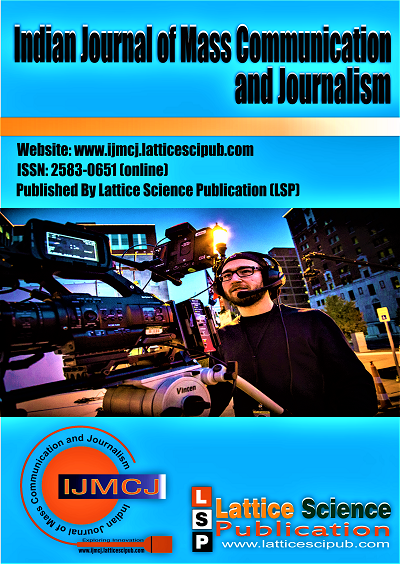Deconstructing Gender Stereotypes in Media: The Transformative Power of Media Literacy
Main Article Content
Abstract
The stereotypical perception of certain groups or communities has emerged as one of the most serious challenges in our multicultural, globalized society. While globalization has facilitated new economic opportunities and the free flow of resources, technology, ideas, and culture, market-driven consumerism has, on the other hand, narrowed human perspectives by promoting stereotypical projections and perceptions. This poses a significant obstacle to the development of a truly interconnected and inclusive multicultural world. The increasing stereotypical portrayal of men and women by the media remains a critical concern for society, and current trends suggest that such portrayals will persist in the long run. This article is a modest attempt to highlight the various gender stereotypes perpetuated by the media and explore the potential of media literacy in countering these stereotypes. Grounded in a qualitative approach, this study employs a Narrative Literature Review as its research method. The review synthesizes existing literature from multiple research databases, including JSTOR, Google Scholar, ResearchGate, Academia.edu, and CORE.uk, offering a thorough, critical, and objective analysis of the topic. On the one hand, the study provides a comprehensive examination of the portrayal of gender stereotypes across various media platforms; on the other hand, it investigates the transformative potential of media literacy in challenging and counteracting these biased and stereotypical narratives.
Downloads
Article Details

This work is licensed under a Creative Commons Attribution-NonCommercial-NoDerivatives 4.0 International License.
How to Cite
References
Ahuja, K. K., & Pundir, T. (2022). Dreamgirls in tinseltown: Spotlighting body image stereotypes and sexism in popular Indian media. Journal of Psychosexual Health, 4(2), 76–79. DOI: https://doi.org/10.1177/26318318221091913
Castronuovo, L., et al. (2021). Food marketing and gender among children and adolescents: A scoping review. Nutrition Journal, 20, 52. DOI: https://doi.org/10.1186/s12937-021-00706-4
Chakravorty, N., & Bera, S. (2024). Portrayal and perception of male chauvinism and gender superiority in Hindi cinema: A case study of the film ‘Animal’. Journal of Communication and Management, 3(1), 83–91. DOI: https://doi.org/10.58967/jcm.2024.3.1.83
Chen, M. (2024). Redefining female identity through the female gaze: A comparative analysis of feminist cinema. Communications in Humanities Research, 43, 168–173. DOI: https://doi.org/10.54254/2753-7064/43/20240160
Eristi, B., & Erdem, C. (2017). Development of a media-literacy skills scale. Contemporary Educational Technology, 8(3), 249–267.
DOI: https://doi.org/10.30935/cedtech/6199
Fernandez, M., & Menon, M. (2022). Media influences on gender stereotypes. IAHRW International Journal of Social Sciences Review, 10(2), 121–125. https://ssrn.com/abstract=4270636
Handa, S., & Rossner, K. (2023). A national comparative content analysis of gender stereotypes in children’s TV shows. Journal of Student Research, 12(1). DOI: https://doi.org/10.47611/jsrhs.v12i1.4162
Hobbs, R. (2024). Media Literacy in Action: Questioning the Media (2nd ed.). Rowman & Littlefield.
https://www.bloomsbury.com/us/media-literacy-in-action-9781538180136/
Islam, K. F., et al. (2023). Social cognitive theory-based health promotion in primary care practice: A scoping review. Heliyon, 9(4), e14889. DOI: https://doi.org/10.1016/j.heliyon.2023.e14889
Kaur, J., & Kanwal, R. (2025). Gender representation in the print media: A study of women’s issues in Indian newspapers. Communications on Applied Nonlinear Analysis (advance online). https://internationalpubls.com/index.php/cana/article/view/5149
Kushwaha, R. (2024). The impact of social media on women's physical appearance and self-esteem: A feminist perspective. World Journal of Advanced Research and Reviews, 21(3), 253–262. DOI: https://doi.org/10.30574/wjarr.2024.21.3.0577
Lal, S. (2023). The portrayal of women in Indian television advertisements and its impact on Indian women. Proceedings of the Global Conference on Women’s Studies, 1(1), 1–14. DOI: https://doi.org/10.33422/womensconf.v1i1.18
McLean, K., et al. (2021). Gendered stereotypes and norms: A systematic review of interventions designed to shift attitudes and behaviour. Heliyon, 7(4), e06660. DOI: https://doi.org/10.1016/j.heliyon.2021.e06660
McQuail, D., & Deuze, M. (2020). McQuail’s Media and Mass Communication Theory (7th ed.). SAGE. https://uk.sagepub.com/en-gb/eur/mcquail%E2%80%99s-media-and-mass-communication-theory/book243524
Mukherjee, S. (2024). Swipe right for tradition: Decoding gender constructs in modern Indian matrimony through media representations. Critical Gender Studies Journal, 1(1). DOI: https://doi.org/10.21659/cgsj.v1n1.08
Nazarnia, M., Zarei, F., & Rozbahani, N. (2022). Development and psychometric properties of a tool to assess Media Health Literacy (MeHLit). BMC Public Health, 22, 1839. DOI: https://doi.org/10.1186/s12889-022-14221-6
Park, Y. J., Chung, J. E., & Kim, J. N. (2022). Social media, misinformation, and cultivation of informational mistrust. Journalism, 23(12), 2551–2570. DOI: https://doi.org/10.1177/14648849221085050
Ravishankaran, K. R., & Senthilkumar, N. (2023). Gender representations and portrayal of adults in children’s television advertising. Frontiers in Psychology, 14, 1234678. DOI: https://doi.org/10.3389/fpsyg.2023.1234678
Santoniccolo, F., Trombetta, T., Paradiso, M. N., & Rollè, L. (2023). Gender and media representations: A literature review. International Journal of Environmental Research and Public Health, 20(10), 5770. DOI: https://doi.org/10.3390/ijerph20105770
Spinner, L., Cameron, L., & Calogero, R. (2018). Peer toy play as a gateway to children’s gender flexibility. Sex Roles, 79, 314–328.
DOI: https://doi.org/10.1007/s11199-017-0883-3
Ward, L. M., & Grover, P. (2020). Media and the Development of Gender-Role Stereotypes. Annual Review of Developmental Psychology, 2, 177–199. DOI: https://doi.org/10.1146/annurev-devpsych-051120-010630





